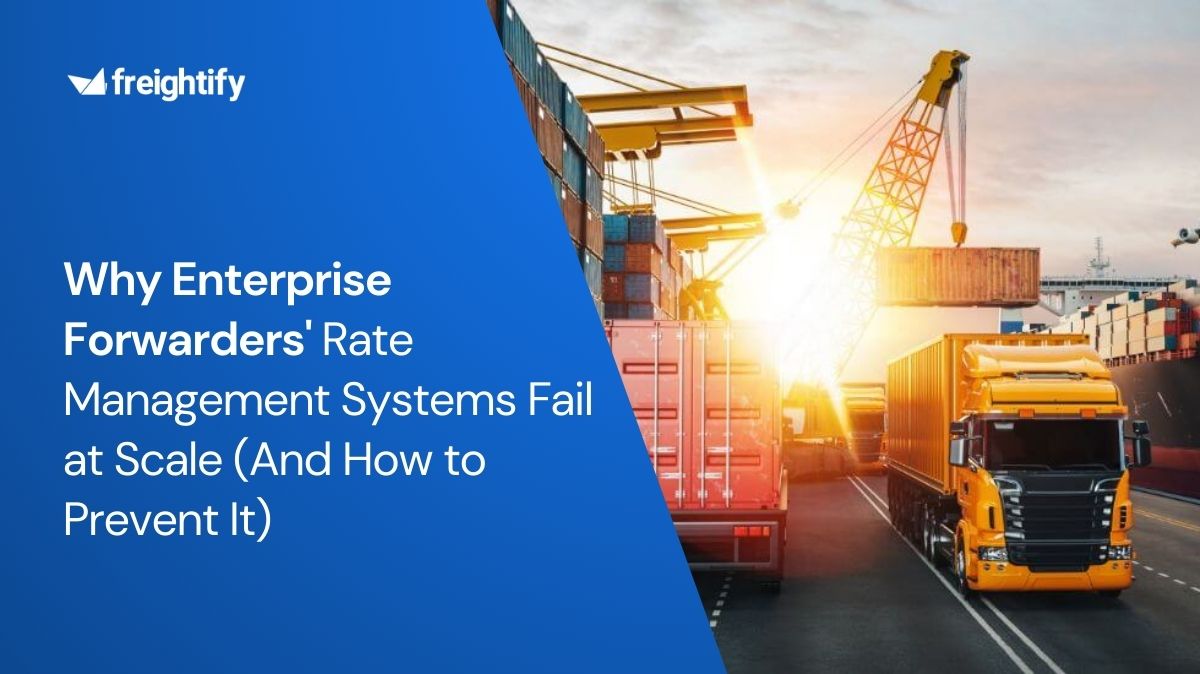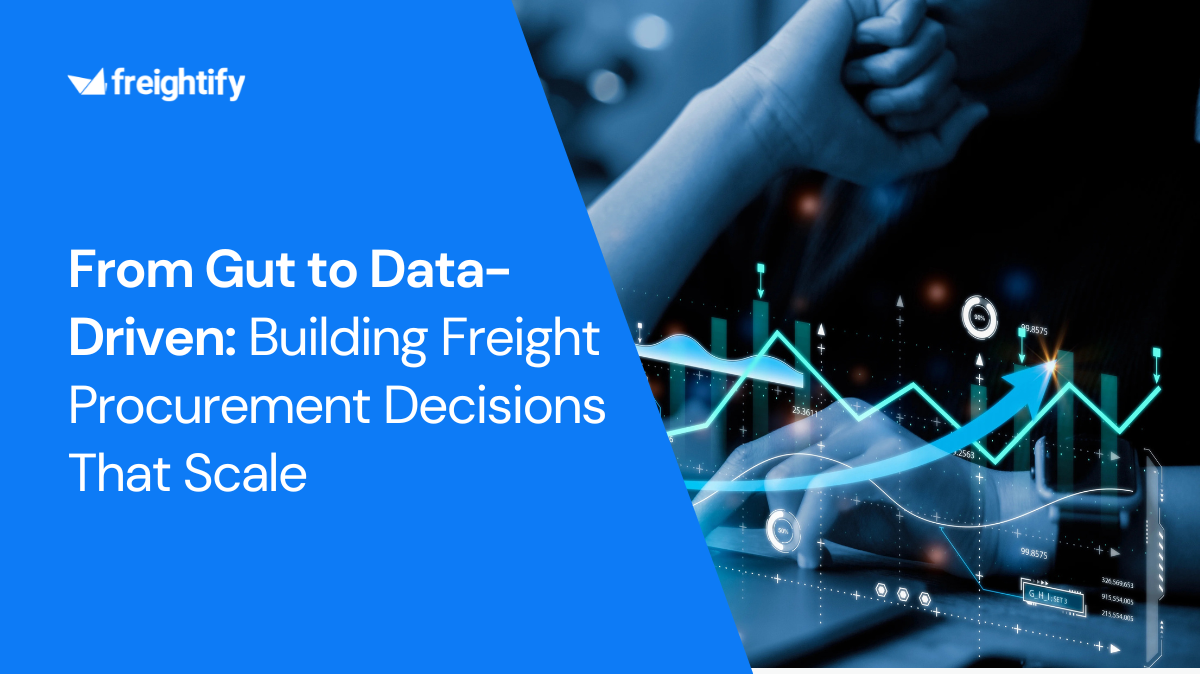Digitalization is the key to all successful and modernized supply chain networks today.
Freight forwarding is no exception, as freight forwarders play a crucial role in the global supply chain.
As the intermediaries between carriers and shippers, forwarders are the starting point of contact when any cargo reaches the port, which allows them to be connected to various stakeholders.
Freight forwarders also manage huge amounts of data from airlines, shipping lines, and transportation companies. This makes it extremely important for freight forwarders to use modern digital tools to ply their business.
Not only can digitalization help them be future-ready, but it can also allow forwarders to expand their business globally.
What's in this article?
Let us help you with your journey
Procure, Manage and Quote freight prices (with ancillary charges) in under 2 minutes!
Why do freight forwarders need digitalization? Freight forwarders have to be the common point of contact between shippers, transportation companies, airlines, railways, retailers, and manufacturers, making coordination and communication a struggle.
It is even more troublesome for forwarders juggling operations in different time zones.
Stakeholders may not be using the same transportation management (TMS) or other systems, which could result in data quality from different stakeholders that may be incompatible, irrelevant, or obsolete.
It also increases the focus on the workforce since forwarders need to ensure accuracy through manual processes when systems are incompatible.
Data quality plays a considerable role when managing a supply chain. Obsolete or irrelevant data raises the risk of poor decisions and delayed actions, both of which can damage a forwarder's reputation.
With competition as tight as it is, customer service is becoming one of the few remaining differentiators for organizations looking to stand apart from the competition. Digitalization provides such an important boost to customer service as well as daily operations that it can’t be overlooked any longer.
How does digitalization benefit freight forwarders? Becoming a digital freight forwarder is the need of the hour. Digitalization has various benefits.
Quicker quoting processes Normally, customers wanting to book forwarder or importer services must go through a long process. Starting with rate management, customers must get in touch with different shipping lines or companies. They then select the best pricing and send a booking request to the forwarder.
But a digital system like Freightify’s Customer Portal completely negates all these steps in the process. A customer can get detailed quotations from this platform in a few clicks. With a transparent and AI-powered rate management system, customers can get the best offer relatively quickly, making this a great tool for forwarders.
Customers may still negotiate on additional rebates for higher business volumes or similar factors, but digital tools like this make the process much more seamless. As a direct result, freight forwarders gain more business, even in different time zones and outside traditional work hours.
Reduction in paperwork A freight forwarder or importer must go back and forth with paperwork for the various processes before cargo is ferried.
From receiving the customer request to receiving and sending approvals to the shipping line to requesting customs clearance, all require a ton of documentation. Both the customer and the freight forwarder need to be very careful with documentation or run the risk of paying heavy penalties and fines.
Presently, there is a lot of room for error in this system.
But with digital tools, this error can be avoided. For example, when using Freightify’s customer-facing platform, stakeholders can access digital document storage, which ensures that paperwork is reduced and documents can be stored and quickly accessed by the relevant parties when needed.
Easy tracking and tracing Shipment tracking and tracing are key aspects freight forwarders need to monitor.
A shipment tracking system essentially updates importers or freight forwarders and their clients on the location and status of their cargo.
Traditionally, forwarders may get data on shipment locations from the shipping company. But this data may not be accurate or timely.
Instead, forwarders can receive the latest updates and information simultaneously when they utilize a digital tracking system in sync with carriers or other transport.
Using a digital system means that all the parties involved in the shipping process can stay on the same page and make relevant communications with the customer awaiting their shipment.
For instance, with Freightify’s Track & Trace function, customers can get real-time notifications or alerts about their shipment.
Real-time information about ETAs (expected arrival time) makes planning for disruptions easier.
Freight forwarders also don’t need to track vessels and cargo manually and can focus on adding more value to other processes.
From shipment departure to delivery, every milestone can be traced and tracked. Customers and forwarders can also create milestones or benchmarks that are more relevant to their processes.
Finally, it is also possible to gather and study the data acquired from different processes of the supply chain to make operations more efficient.
Data storage and analytics for better forecasting Digitalization makes it possible to acquire vast amounts of data on various important points.
For customers, the focus may be on shipment tracking; for importers and forwarders, the focus may be on rate management and procurement, quotations, and more.
All these processes can benefit from data analytics.
With the functionality to store relevant data points online, shipping processes can be improved. As a result, the risk of delays or missed pickups is reduced. It also allows companies to seamlessly share documents like bills of lading, invoices, and other important documents.
Advanced data analytics allows forwarders to create more precise rate management and freight forecasts.
Data analysis can help freight forwarders to get insights on optimizing the labor force, rate management and procurement, and risk management, among other services. All of this can foster better co-operation and build trust amongst the various stakeholders involved.
Not only does digitalization help forwarders provide a great customer experience, but it also opens more sales channels.
What processes can go digital, making life easy for forwarders? Freight forwarders play an important role in the global supply chain and transportation ecosystem.
They organize transport for shippers, carriers, and other stakeholders. Their main role is moving goods from point A to point B by air, sea, or land without having assets like planes, trains, vessels, or trucks.
In order to ensure this goal, freight forwarders need to engage with various entities and work on various systems.
As a result, shippers don’t need to deal with stakeholders like carriers, warehouses, ground handling agents, documentation experts, customs agents, and more. All the processes with these parties fall under a freight forwarder’s domain.
Traditionally, all these processes happened manually, with a large room for human error. But digital systems and tools allow forwarders to overcome these errors.
Many traditional functions typically carried out by freight forwarders can now be automated by using a digital system. These functions include, but are not limited to:
Digital document transfers Invoicing Shipment tracking and tracingShipment updates Digital document storage Customs declaration systems Warehouse and Transportation Management Freight forwarders are the central node that handles all communication from these various stakeholders for their clients.
Automating processes allows forwarders to optimize time, cut costs, and improve reliability for their clients and throughout their network.
How can forwarders integrate various processes into one digital system? While there are many tools and systems forwarders have access to, the difficulty lies in ensuring that all relevant data points forwarders need are available in one place.
Some of the data forwarders need to access to includes:
Logistics and timing data Ocean freight data Real-time shipment tracking Data from various sources (carriers, other NVOCCs, truckers, warehouses, yards) to provide the best rates for importer services The lack of accurate real-time data and an integrated platform to manage rates, documentation, and visibility is a hassle for forwarders operating manually. Forwarders also tend to lose out when international clients cannot connect with them despite competitive rates because their time zones differ.
A digital system that integrates all these data points and processes can help transform the whole manual process for a forwarder team.
Forwarders can integrate various processes and systems using an integrated digital portal like Freightify.
With their TMS integration, forwarders can connect Freightify’s system to other transportation management software.
They can also access Freightify’s rate management and procurement platforms, connect with customers across the globe and get analytics.
Forwarders can expand their business and sales by being available 24x7 to prospective customers with Freightify’s customer portal.
In conclusion, forwarders can add more value to their operations by utilizing a real-time freight data system in their software suite.
To this end, the need of the hour is investing in integrations that help you acquire and analyze real-time data and gain visibility into everything from container tracking to rate management.
This can help companies and individual players gain the competitive edge to make more insightful decisions and better top and bottom lines.




















